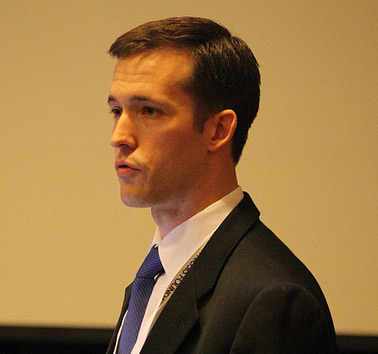Endometriosis Foundation of America
Endometriosis 2013 / Endometriosis is Not a Benign Disease
Michael Beste, PhD
Thank you very much for the introduction and the very kind invitation to speak today and share with you some of our recent work at MIT. As the chair said I am a post-doctoral associate working in close collaboration with Linda Griffith who sends her regards. She was not able to join us today she had a conflict down at NIH but she will be returning this evening. But she was very remiss to miss this morning's sessions.
Together with Keith Isaacson, Linda and Keith came together to found in 2009, now some of you know, the MIT Center for Gynopathology Research, which was motivated out of a recognition for the need for greater focus on the basic biological and engineering sciences for developing innovative strategies to cell molecular research for such a complex disease.
What I would like to share today with you in the next 15 minutes are some of the strategies we are thinking about and some models we are starting to build to think about how do we approach such a complex disorder. I look very much forward to getting feedback, if not immediately after this talk, then certainly at the end of the session during some Q&As.
I think it goes without question in this audience that endometriosis is not a singular phenomenon. It is very much a continuum as we heard this morning from Dr. Martin in terms of both the symptomatology but also the clinical manifestation that is observed inter-operatively, both in the lesion morphology but also in the local histology and local placement of the lesions. One might argue that at the very mild end of the spectrum, what some might call benign disease or asymptomatic endometriosis we have incidental findings of disease that often arise in procedures unrelated to pelvic pain or even infertility. Often we hear anecdotes of "well, endometriosis was there, that's not why the patient came in" but as we move towards the other end of the spectrum we can start to recognize and appreciate highly invasive disease, and even, perhaps, a progression towards malignancy. I think there is very fascinating work coming out showing the potential relationship between certain forms of endometriosis and certain malignancies but really in between we are confronted with a diverse continuum. That continuum is problematic both from the clinical perspective but also scientifically because the symptoms that a patient may present with are not necessarily concordant with the pathological and surgical observation in the OR. There is this disconnect between what we can see and objectively observe and what the patient reports and experiences, both perioperatively prior to treatment but also post-operatively. In order to wrap our minds around this problem we have constructed a framework focused on three specific questions that I would like to introduce. The first is how do we better stratify patients? This is not a revolutionary concept but a key one that we think holds a lot of potential, particularly for endometriosis because models have been well established elsewhere. So this might be pre-surgical stratification but also post-surgical stratification in terms of classifying patients into appropriate risk categories for recurrence or identifying optimal medical treatment regimens.
Second, we are very interested in the molecular mechanisms of disease. That is fundamentally at a DNA, protein, micro RNA, glycol-protein level, metabolite level. What are the pathways that are dysregulated that give rise to this highly destructive phenomenon. The motivation here is really around identifying mechanisms that we can target with novel therapeutics. Obviously there has been a great deal of success in identifying the concept of ectopic aromatase expression. I think we are starting to see a real benefit from aromatase inhibitors in the clinic but we want to think even more broadly than that. How can we bring unbiased approaches certainly with the ongoing trends and movement towards systems technologies? How do we identify even more opportunities for therapeutic development? And, finally, if we can really nail down some of these mechanistic pathways can we start to talk about prevention? Because ultimately what we would love to do of course is identify complex interactions, say, between the environment and genetic background that predispose certain women to this complex pathology.
A familiar paradigm that we think about a lot and informs our thought process as we approach this problem is certainly a model that many of you will be familiar with, and that is the concept of consensus molecular markers and heterogenous disorders such as breast cancer. Here it is well recognized that molecular phenotypes and cellular phenotypes may be approximately categorized according to receptor expression levels and these receptor expression levels have been shown, time and time again, to correspond very well with advanced and aggressive sub-classes of tumors as well as less aggressive and less metastatic forming lesions themselves. What we would hope is that as we think about developing these types of strategies for endometriosis that we can develop similar prospective risk profiles that would better inform patient management.
Now, what I will come back to at the very end is of course the intrinsic challenge that doing longitudinal studies on endometriosis is a very significant challenge. A not impossible challenge but to do it with the efficiency and the infrastructure that we currently have at hand is often quite prohibitive. We want to think about tools and infrastructure that we can actually develop to help facilitate this.
Three of the guiding principles that I will introduce today are that we would like to develop and define robust biological assays that capture this heterogeneity. If we are going to move towards a molecular cellular basis for diagnosis and prognosis we need to have similarly diverse measurements that objectively capture the phenotypic diversity that is referred to us by the patients but also referred to us by the clinicians who visualize the lesions intraoperatively. We argue that these should be assays that complement the information not compete with it but rather complement that traditional assessment of lesion characteristics with objective measurements that can be standardized across the field.
Secondly, we want to characterize biological states in an unbiased manner. There is a great and growing trend towards "omic" technologies and a general philosophy that it is best not to look under the lamppost where you think you lost your keys but consider a more unbiased approach where all elements come into play and that we give a fair and uniform assessment of, all sites of molecular lesion for instance. I will talk a little bit about some of our work in this area and finally I will come back to ways that we can develop tools to collect structured data sets from patient populations for things like longitudinal monitoring.
When we started out we took a very critical look at the literature looking for direct evidence in support of Sampson's hypothesis. Despite a number of very fine studies showing the presence of endometrial tissue fragments and cytological preps and other cellular specimens there was virtually none, all but one actually, publications demonstrating the presence of viable endometrial cells in peritoneal fluid. By viable I mean cells that can be removed from a patient during an operation, cultured in vitro and be shown to proliferate and actively divide such that this is an assumed prerequisite to the implantation hypothesis. To address this we conceived a rather simplistic assay that was motivated by some previous work in our lab with bone marrow differentiation assays as clonogenic colony formation assays where we would simply collect peritoneal aspirates from a diversity of patient populations undergoing surgical procedures either for endometriosis or unrelated conditions. Ex-vivo culture those specimens and see if we cannot simply observe the outgrowth of endometrial cells as a direct test of the retrograde menstruation hypothesis.
I will note here there is a caveat, a very important caveat that all retrograde menstruation is not this clean, uniform sample. It is a mixture of single cells, tissue fragments and how you actually analyze those in a quantitative way is actually quite problematic. We had to think very carefully about how we standardize this assay across many patients but ultimately we came up with a protocol that allows us to look, again, quantitatively on a frequency basis the absolute frequency of endometrial arising colonies, as we called them, or proto-colonies that appear in our endometrial cultures.
This is simply a day 14 immunoflorescent stained culture of what we would argue would be suspect endometrial fibroblasts that we have recovered in that culture from a peritoneal aspirative of cycle day three patient who was actively menstruating at the time of her surgery. Not only can we show that these colonies have a characteristic morphology of endometrial stromal cells and express endometrial specific markers such as CD10 and Vimentin but given an appropriate differentiation stimulus they can also be induced to secrete things like prolactin. We are starting to build a collection of evidence to show that no only at kind of a tissue cultural level but also at a cell functional level we can, in fact, start to go in and find the precursors perhaps to some of these endometrial lesions.
Now, I should emphasize that the results we have obtained across a spectrum of patients now has been highly diverse. The best argument that I can make in support for Sampson's hypothesis is that we only see these colonies arise in patients who are menstruating. Outside of that seven to ten day window these colonies are virtually absent in our hands at least. Even within the patients that show robust colony growth there is a great diversity of not only the frequency of colonies that we observe per patient but also in their size characteristics and proliferative potential. Simply on the top panel here I am emphasizing that the results that we see range from anything from a single colony all the way up to something that is nearly uninterpretable given the numerous colony outgrowth that we see. Just to give you a sense of scale here each of these culture chambers corresponds to a 2 cm by 2 cm culture area. In the lower panel I have simply enumerated the total number of colonies that we observed in a series of controlled patients in which endometriosis was unobserved and then a series of five patients in which endometriosis was conclusively diagnosed by pathology. And while the size distribution between patient cohorts was quite similar you can easily appreciate that the total number of colonies in an endometriosis cohort was significantly greater.
As I said, we are also interested, very much, in identifying in kind of an unbiased manner molecular targets for novel therapeutic interventions. One of the complimentary projects that has paralleled the development of this colony assay is a systems level analysis of inflammatory cytokine biology within the peritoneal fluid. These colonies do not form even in vivo in the absence of inflammatory background and we have been very interested in the immune cell networks that mediate protection against endometrial cell implantation and clearance in the peritoneal cavity. We have conducted now a rather respectable size study consisting of approximately 25 control patients and 60 endometriosis patients where we have characterized absolute levels of approximately 50 cytokines in the peritoneal fluid. This is not a new approach this is something people have done for many years but what we have argued is that an unbiased approach that looks at mini-markers simultaneously will give us a strategic advantage to identify those markers that are going to be most useful for developing things like a clinical decision tree. In the center panel here I simply highlighted the cumulative results of our analysis and on the right a signature set of a dozen or so cytokines that show strong predictive capacity across the patient subgroups.
If we use a number of unsupervised machine learning analyses we can self-categorize these patients where each patient...represented. Here is a vertical column of inflammatory cytokine markers. We can self-categorize patients into coherent molecular subgroups. What is nice now is that we can come back and look at the clinical metadata that we have collected for those patients and show very nice clustering of the symptoms. Here we have seen, for instance, a very significant dichotomy between the severity of pain symptoms, particularly dysmenorrhea, between kind of this moderately inflamed group of patients and the more severely inflamed group of patients.
Just to conclude I would like to highlight a more recent project that we have included in our work which was really kind of a really fruitful collaboration that has arisen as recently as this past fall between our center and the MIT media lab, which has its hands in lots of different creative areas around campus. But one of our collaborating professors, Professor John Guttag, has now for the past three years organized a health and wellness innovation conference, which is part conference and part week-long Hack-a-thon. Students, both undergraduate and graduate students, come together with health care professionals and software developers to put together and start pilot projects around software development applications. They can help us better capture the very nuanced facets of clinical experience from the patient's perspective.
What I would like to present today is some work that was piloted by a team of undergraduates. One of our undergraduates, Nurshin is here this morning and I would encourage you to meet with her afterwards. This is some really exciting work that she and her team of fellow undergraduates have put together. Our hope is that in developing a molecular mobile platform developed around kind of the app model that so many of us have on our mobile devices these days we can create a real time feedback mechanism between the patient and the primary care physician and/or surgical care physician. Just to give you an example of what we have in mind for this type of approach is shown here. Some of these pilot screen shots that Nurshin and her team have piloted now in kind of a beta version of the app that will be maturing going forward but this is effectively a daily journaling system. A patient can come in and both perioperatively prior to a surgical procedure, and post-operatively, monitor her daily wellness both at a physical and mental level according to a prescribed structured data regimen that a researcher or clinician can prescribe. Here we have simply shown some daily timeline, if you will, of some key health care monitoring activities such as monitoring of bleeding and mental health awareness, which we would argue is equally important in discerning some of these finer categories of pain and the experience of pain. But also as the patient progresses through a treatment regimen that might possible include conservative excision surgery gives them the mechanism to communicate with their physician in real time on a day to day, or at least weekly basis how their symptoms are regressing, are being sustained or increasing in severity over time. Nurshin and her team have again come up with some very nice graphical aids to facilitate this. Our hope, ultimately, is that these are the types of tools that are going to facilitate the more rigorous longitudinal studies that again borrow from this model of consensus molecular markers and invasive disorders such as breast cancer and colon cancer, prostate cancer that allow us to start to answer more nuanced questions at a high resolution of clinical detail. That is again not to say that these studies are impossible right now but we would like to hope that we can hopefully move along a direction that provides some tools to the community to collect this information with greater ease.
I would just like to thank our collaborators this morning. This has been a diverse experience between the Department of Biological Engineering, MIT, including systems biologist like Doug Lauffenburger, material science expertise from Paula Hammond and Jongyoon Han, as well as a number of close clinical collaborations in the Boston area including Keith..., Stephanie Morris, fantastic epidemiological insights from Stacey Missmer who many of you know, and of course Catherine Racowsky who is closely involved in a number of our infertility studies.
I would like to thank you for your attention this morning and certainly welcome any feedback or questions at the conclusion of this session.










